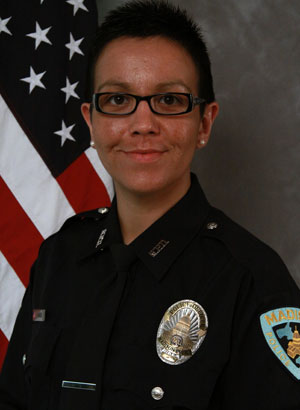
Investigator Joanna Hollenback
My name is Joanna Hollenback, and I am an investigator in the Forensic Services Unit with the Madison Police Department. I am a police officer, it’s a promoted position, and I do crime scene processing. I have been with the Police Department there in Madison for almost 10 years.
What we are tasked with in our unit is we deal with assisting patrol in documenting their scene, whether it’s a low level scene with a case of battery and somebody being arrested for having battered at someone else and they need the injuries documented by photographs. I respond to those calls and take photos of that victim of their injuries to be later used in the case, if necessary. We process large scenes. If we have, for example, a homicide, we go to those scenes and document with photography, with video, we diagram the scenes and we collect the evidence in conjunction with working with detectives and oftentimes the violent crimes unit. As investigators at my agency, we collect the evidence, and if the evidence needs to be analyzed it would be sent to scientist at a crime lab.
In my job now, I am dealing with the crime scene and evidence, as opposed to, I’m not interviewing people anymore. I don’t write up Probable Cause or the charges, that’s done by a detective or an officer.
Part of what our job entails is we go into these scenes and sometimes they are very graphic in nature. They’re always tragic, especially when it’s a homicide, because somebody has clearly lost their life. Our job is to document that scene to provide the best picture of what happened based on the evidence we’re seeing and what the scene looks like when we arrive.
We had three homicides in eight days. One of the calls that I ended up on was a homicide on the south side of the city late at night. We had two victims shot at a gas station. One passed away at the scene and the other fortunately survived. It was a large scene with part of it outdoors because one victim was shot outside by the gas pumps. The other victim went down inside the store. There was lots of damage, broken glass and blood and vehicles. The only reason I ended up on that call was because I happen to have overtime on my shift. I had a late weapon defense come in just after 10. That took me took me a little over an hour to work.
I got back downtown and was overlapping with the night investigator. We just happened to chitchat as I was wrapping up my things when the alert tones went off and all of a sudden, we kind of paused. It’s just kind of that natural pause you do as a cop. When you hear your weapons tones go off, everyone pauses to listen.
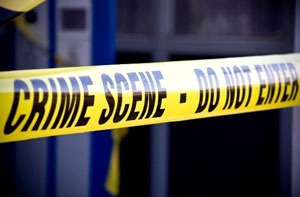
We do prefer to work a homicide with two people. It helps divide the work and we make sure we don’t miss anything, and we are able to help each other. So, I stayed on then and he and I went to the scene and began working that scene.
It’s challenging because we have a job to do, but we have to work around this body that we have in our scene. And when you have a scene, especially one like that, where you have some things inside, there’s some things outside, family starts showing up. You have lots of officers on scene that are helping manage the perimeter and security and trying to manage all these emotions. I still have a job to do. But you spend a lot of time in those areas where there’s things that normal people don’t ever want to have to see nor should they, and you have a job to do so.
The Autopsy
We go to the autopsies we are dressed in scrubs, and am with the forensic pathologist and the morgue tech. We are in the room as they’re doing the autopsy because any evidence collected from the body is turned over to us and we start that chain of custody.
There is a procedure of documentation, of swabbing, of cleaning the body, and then actually going into the body to locate items. The procedures include documenting what is damaged, what organs are damaged, the path of travel of the bullet, what that bullet hit as it traveled through the body. When they get to the point where they are removing that bullet from the body, they turn that over to an investigator and we take custody of it.
From an autopsy we collect any foreign object from the body. We will collect any and all swabs that the doctor did of the body. And we will collect all of the clothing that the person may have been wearing when they were shot. So, all of those pieces of evidence are turned over to us at the autopsy.
Overcoming CSI Show Expectations
One of the challenges that we find in forensics is that we are constantly working against what people see on television and what they think is forensics, or what they think can be done. And some of those things are made up for TV. So, we’re constantly having to educate that actually isn’t the case. We need to do this or that and try to educate as we go.
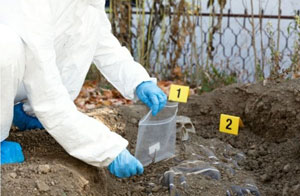
The reason is that when you go to swab an area, it depends on the texture of the surface. The rougher the texture, the better the chances that they’re going to sluff off cells on that item. But it also is dependent on the length of time of contact. Even in an armed robbery at a gas station where maybe the suspect doesn’t wear gloves and they grab the forearm of the clerk and its skin-to-skin contact. Maybe they see the clerk going to reach for a phone and the suspect grabs the clerk’s wrist. That’s a situation where we may swab the person’s wrist if they made sure not to cross contaminated by touching it again. But with the nature of the contact, we may not get enough skin cells to give a full profile when it’s analyzed on the road. So, that’s one of the misconceptions is that if you swab for touch DNA, that you always get enough to ID who that person is, and that’s not the case.
The other problem with that is if it’s an item that is handled by many, many people, then anything you may get back maybe diluted. So you won’t have enough to get a full profile to match anybody that might be in any system that we’re able to check. So that’s one of the misconceptions.
Sometimes there’s just not enough there that is detectable once the sample is sent for analysis. So, that’s one of the things same things with fingerprints. Fingerprints are great ways to identify suspects. But depending on the surface, the surface might not be a great surface that’s going to pick up those oils from the skin to leave that latent print there in order for us to lift it.
Those are two things that come up somewhat regularly when we are called to a scene to assist with documenting whatever was located at that scene. We could dust a dresser drawer that clearly was pulled out and the homeowners saying all these doors were shut when I left overnight and now, they’re all pulled out and I can dust them and there’ll be nothing there.

There are times when we are the bearers of the bad news, where unfortunately this may come back with nothing. There may not be enough there, or nothing shows up when it’s taken to the crime lab.
We are always trying to strike that balance when we’re collecting evidence at the scene. What is the forensic value of that evidence? Is it direct evidence like fired cartridge cases that show that a gun was fired? Yes, we absolutely would always collect fired cartridge cases, but it doesn’t necessarily show specifically where the shooter was standing. The reason for that is those cartridge cases when they’re rejected, for example, from a semi-automatic handgun, they eject to the right. But if you’re standing by a wall or a chair or any item that can bounce that shell off from it, where it lands could be anywhere in that room or if you’re in a vehicle. The cartridges can show that a gun was fired in this general area, but we can’t speak with certainty that the person was standing three feet left of this pile of cartridge cases. Not with any degree of absolute certainty can we say that.
Consulting with the Detective
I want to make sure I’m consulting with the detective because they’re gathering the information about from either the witnesses or the surviving victims. The victims are describing what happened in this room that I am now standing in and trying to document. Does what I am seeing corroborate what they are seeing or are they contradicting? We want to communicate that information back and forth. I may say to the detective, the victim says they said they were shot in the bedroom, I only have cartridge cases in the kitchen. What happened in the kitchen? Can you go back and ask them? Because unless they got carried from one room to another after they were shot, that doesn’t match up with what I’m seeing.
It’s like you’re working this puzzle where you may or may not have all the pieces, but you’re trying to complete the picture as fully as you can, knowing that at the end of the day, you may never know with a hundred percent certainty exactly what happened
Human recall can vary. People may forget details of an incident because it was so quick or it was so violent or they got knocked out, there are a variety of reasons. Not just because people want to lie. It’s just they may not recall exactly what happened when it happened and how it happened.

It’s this constant problem solving as you’re trying to answer these questions. Is that all of the evidence, or did we miss evidence? Is there something else? Was there blood somewhere that we missed, or we didn’t see that they tried to clean up that we need to go back and revisit and look for. It’s this ongoing process of trying to build your case and making sure that you find any evidence that is to be had and that you’re handling it and collecting it appropriately and maintaining the chain of custody as to not contaminate your evidence because you want it to be the best and strongest possible as that case moves forward.
The Hardest Crime Scenes to Process
The hardest scenes to process, and just in a very general way, are death investigations, whether they are a death by homicide or a death that’s natural or suicide or undetermined. And I think what adds to the level of challenge is, for example, if you have a suicide where perhaps the person was discovered by a friend or family member, and then by the time I get there to assist in documenting that team, seeing you have a gathering of friends who are highly emotional or family. I have a job to do, and I can do that job and patrol officers have their jobs to do, and they’re assisting with scene security or interviewing people and trying to get back on information. But when you have all those emotions of those people that are physically there, either in or near your scene, you know, maybe we have them in the front yard because the scene is in the kitchen, and we need to have the house clear so that we can do the processing. Those are hard because they’re so emotional and I have a job to do to document the scene, but these people that are outside clearly upset, they have lost someone very near and dear to them. Sometimes it’s a shock, sometimes it’s expected, sometimes it’s a medical event. But I don’t think anyone’s ever really prepared for a death when it happens, regardless of the circumstances, there’s always a level of shock.
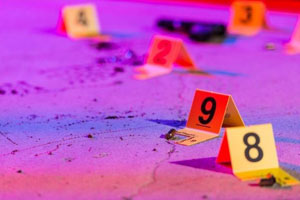
As investigators, we see terrible things because we have the responsibility and the job of going into process those scenes. That’s part of what we have to do, and we have to do it appropriately. We have to be efficient and thorough. But we are exposed to a lot of traumatic things. Other challenging scenes to process include when you have an outdoor scene in poor weather. If you have an outdoor scene in the winter or when it’s raining and you’re the chance for you to potentially lose any sort of biological evidence, or if you have a large scene. We had a house explosion in September of 2017 that was ultimately done to cover up a homicide. We had this vast multilevel scene that’s unstable because there was fire, and you might not even be able to work that scene until one or two or three days into it. And then it’s a multi-agency endeavor. They’re very interesting. And you learn a ton, but they’re very challenging because it’s like finding that proverbial needle in a haystack. Especially in an explosion type scene where you have to sift through the ruble of what’s left of that house to find the victim, to find a possible weapon. It can be really daunting at times to be dealing with these large-scale scenes.
When I have a homicide and I’m working by myself, I’m going to be the only one there at least for the time being, I have relief coming to assist me, but it’s going to be at least an hour. When I get to that scene, I want the scene supervisor, or if there’s already a scene detective there, I want them to walk me through what my scene looks like. I might see the body right away because it’s right there covered with a blanket.
What all are we determining to be the scene? Are there any fired cartridge cases? Is there a knife? Is there a weapon of some sort? Where did the suspect go? Is there a path of travel? I want to know what they know when I get there. So typically, the call comes out. I make be requested at anywhere from 20 minutes to 40 minutes after the call has because they have to stabilize the scene, make it safe, and then they call me in.

By the time I get there, I know there have been changes to that original scene that were necessary, but I need to freeze that scene. So now everyone needs to be out of my scene so I can document it as is at this moment right now. I take a series of photographs documenting wide, overall shots, then medium shots, and coming in and taking close-up shots of anything of note or evidentiary value.
Once I complete all of the photography, if I have a deceased person, then my next step is to go and get my video camera, and I’m going to do a walk-through video of the scene. I will start my video camera at my truck and come through and do a slow walking tour of everything that’s visible on the scene. That’s just to provide a different lens, a moving lens of what is there. There’s no sound, it’s just to provide an additional layer of visual documentation to that scene. Once I get done with that, I go back and if there’s any new information that my scene detective has available to me, they’ll share that with me, or I’ll ask for it.
Marking the Evidence
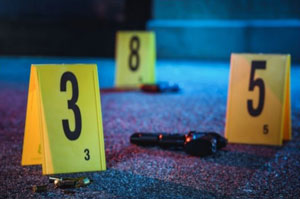
Once I have everything marked that has been located, usually in consultation with the detective, I’ll go back through and do an additional set of photos of all the evidence marked with the placard. That’s just for me to keep things organized because I’ll do a written report after I’m done with all of this, and once I have everything documented, then I’m going to do a. sketch
The Crime Scene Sketch
It’s going to be a rough sketch, but I’m going to be taking measurements with some assistance. Usually, I can have anyone help me because they’ll only need to hold a tape measure. I am marking down distances from points of reference in the scene, whether that’s a wall or a doorway or a light pole or a curb edge for outside. I want to document specifically where those things marked by placards may be in my scene, and that can take a lot of time. I may have a scene of 30 articles marked outside and I want to measure all of it. Only after all of that is done, will I then work with that detective to go through and figure out what are we going to collect out of this scene.
For example, I might have broken glass, the victim was shot standing outside their car and there’s vehicle glass on the ground. I’ll put a placard by it because it’s of note. It happened during this incident, but I wouldn’t necessarily collect that glass. Not unless we determined that there’s a forensic value to having that glass.
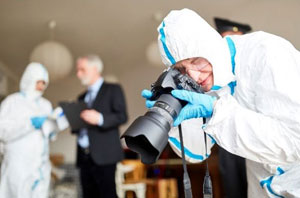
When I go to a call for battery photos, all they need are the photos. I don’t have to do those other steps. I’m literally just going to that scene to confer with the officer, briefly, meet the victim, photograph their injuries.
Processing the Body
On a scene of a homicide and we have a body that is not transported because they had non-survivable injuries and they died at the scene, that body is one of the biggest pieces of our evidence. It is our most important piece of evidence. So, we’ll have an officer stand literally next to that body, it will be covered if we’re outside. But we don’t search through anything on the body until our forensic pathologist arrives on scene. Because that person, that physician, our forensic pathologist, they want the body as is at the time of death. There’ve been times when I’ve been on calls like that where you hear a phone ringing, we’re not going to disturb any of that until it has been documented with photography and our doctor and the medical examiner’s office have been there to do their exam.
Then, depending on the nature of the case and why we think this shooting may have happened, there are some things that once that search of the body commences, it’s going to be the doctor that does that search. We think it’s related to maybe a drug deal that went bad. They’ll turn that phone over to us immediately, which will then go to a detective or myself to take into custody, because we might want to dump the information from that phone at some point after we have the time to do so and get it back to our digital forensics people. But we won’t search that body for anything until we have the doctor with us. And then any personal effects like jewelry or whatnot, the medical examiner keeps custody of but anything that might be evidentiary value related to the crime would be turned over to us as part of our chain of custody with that.
What makes a Good Crime Scene Investigator?
I think in order for you to want to do the type of work processing a crime scene, either as an evidence technician as a civilian, or as an investigator like what I do as a police officer in my agency, you have to be able to deal with seeing a lot of terrible things. I find it a little bit ironic because as police officers, even a patrol officer, we all have those calls, especially the longer you do the job, you have a death investigation, you have a fatal crash, you have all these things you go to, but what’s different about what I do versus what patrol does is patrol has these calls and they may have opportunities to physically step out of the scene or go adjacent to the scene. They don’t have to be deeply embedded in the scene to do their work. They can do the interviews in the room adjacent to where the person’s body is. Whereas my job requires that I have close personal contact with that deceased person. I may need to assist the medical legal examiner in moving that body. I’m stepping through areas of sometimes bodily tissue or blood in order to take my photos of that person or that scene. So, I have a lot of extended contact with really horrible scenes.
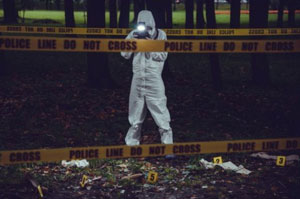
If somebody is considering a law enforcement career, I would not want another job. I felt like when I started this job, I found what I was meant to do and. I’m so proud of the work that we do. At our department, we really value a varied background. So, if you are not a criminal justice major, I don’t want anyone, male or female to think that that is going to work against you in getting into law enforcement. If that’s something you want to do. I think especially at Madison, which is one of the reasons I was really drawn toward this agency, is that they really truly valued diversity.
I take a lot of pride in the fact that we work really well together, and we have a really great team in our unit. I like playing a role in providing justice to these families, by making sure I do all that I can to properly and appropriately documenting the scene, that’s something I want to do every day on every call that I go to.

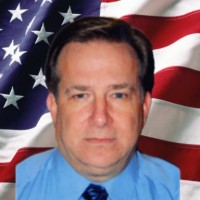 Joseph Libowsky,
Joseph Libowsky,